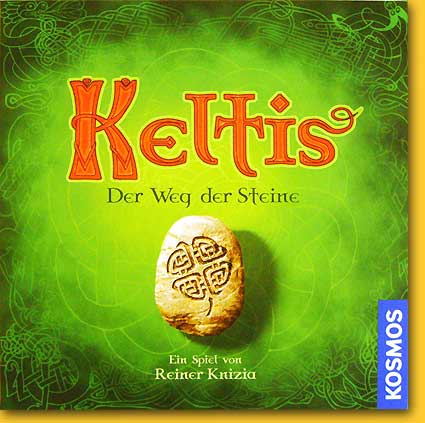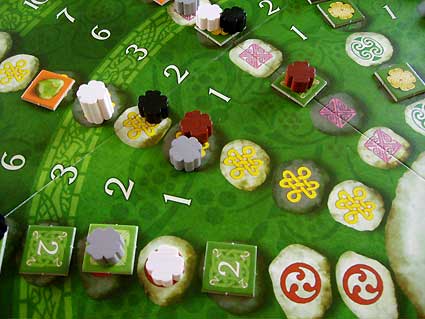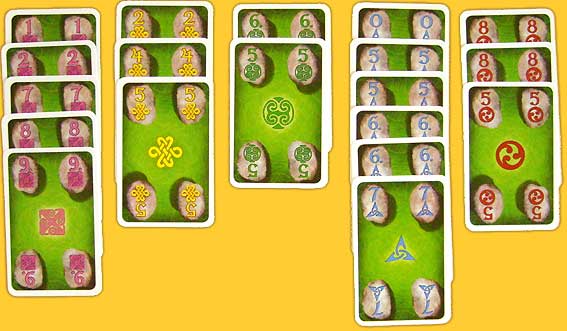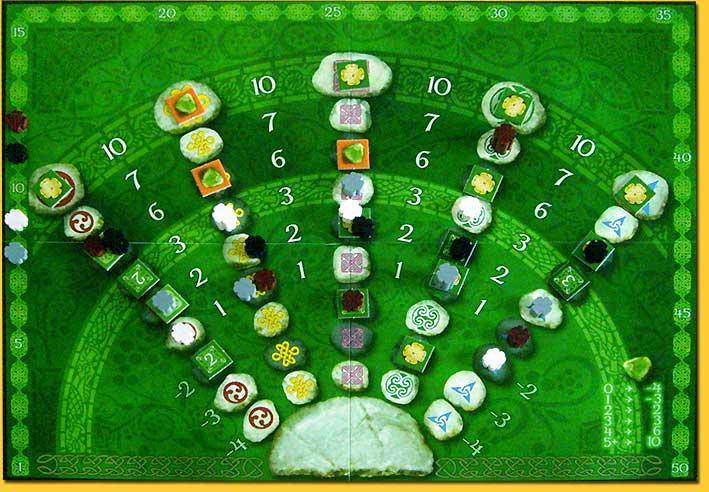Keltis
Author: Reiner Knizia
Publisher: Kosmos
Year: 2008
review by

| x |
|
|
|
|
|
|
|
|
|
|
|
|
|
|
|
|
|
|
|
|
|
|
|
|
|
|
|
|
|
|
|
|
|
|
|
|
|
|
|
|
|
|
|
|
|
 |
Back to the basics: instead of taking us to an imaginary mythical land, with mysterious druids who walk on magical stone paths, using their healing power to divert imminent adversity, the rules straight away start with the announcement that players play number cards in order to advance their pawns as far as possible on the various colour paths. This way we instantly are into the game: each player is dealt eight number cards; the deck consists of five different colours from one to ten, and each colour has each value twice in the deck. |
| x |
|
|
|
|
|
|
|
|
|
|
|
|
|
|
|
|
|
|
|
|
|
|
|
|
|
|
|
|
|
|
|
|
|
|
|
|
|
|
|
|
|
|
|
|
|
|
There are five coloured stone paths, with nine spaces each. In a turn a player plays one colour card for a specific stone path and moves the pawn on this track one space. Each path has a progressive score, from minus four to plus ten points, so it is obvious that playes will want to move their pawns as far as possible on the various tracks.
After playing one card, placing it in front of him and moving the corresponding pawn on the stone path, a player refills his hand, so he always has a choice from eight cards to play.
|
|
 |
| x |
|
|
|
|
|
|
|
|
|
|
|
|
|
|
|
|
|
|
|
|
|
|
|
|
|
|
|
|
|
|
|
|
|
|
|
|
|
|
|
|
|
|
|
|
|
| All cards of a colour have to be placed together and must form a chain, increasing or decreasing. So, after the first card a player still has a choice whether he will continue this series with a higher or a lower number. Equal numbers also may be played, and could postpone the choice for a player of how to continue his series, decreasing or increasing, if such an equal numbered card is the second in the series. A series does not have to start with the one or the ten, but could as well start somewhere in between, although a player would limit himself in making a possible longer series, and consequently the possibility of advancing his pawn on the stone path to the desired higher values. |
| x |
|
|
|
|
|
|
|
|
|
|
|
|
|
|
|
|
|
|
|
|
|
|
|
|
|
|
|
|
|
|
|
|
|
|
|
|
|
|
|
|
|
|
|
|
|
 |
| x |
|
|
|
|
|
|
|
|
|
|
|
|
|
|
|
|
|
|
|
|
|
|
|
|
|
|
|
|
|
|
|
|
|
|
|
|
|
|
|
|
|
|
|
|
|
| During the course of a game a player will get cards in his hands that are no longer of use for him: for instance he has a decreasing series from eight to four, and through refilling he has a six on his hand. Instead of playing a card and adding it to one of his coloured series, he also may discard a card and put it open on top of five separate discard piles, one for each colour. On the other hand, when refilling at the end of a turn, instead of drawing a blind card from the stack, a player may take the top card from a discard pile. This means when a player wants to discard, he first will have to check if the card could be useful to other players. |
| x |
|
|
|
|
|
|
|
|
|
|
|
|
|
|
|
|
|
|
|
|
|
|
|
|
|
|
|
|
|
|
|
|
|
|
|
|
|
|
|
|
|
|
|
|
|
 |
|
Everything under control, and no prob; with the added element that at game start various chits are randomly placed on the stone paths that make for an extra incentive: additional points, four-leaf clovers, and wish stones. When at game end a player did not collect enough wish stones, he gets minus points , from minus four to minus two, but if he properly picked these up, he could earn up to ten bonus points. |
| x |
|
|
|
|
|
|
|
|
|
|
|
|
|
|
|
|
|
|
|
|
|
|
|
|
|
|
|
|
|
|
|
|
|
|
|
|
|
|
|
|
|
|
|
|
|
| The points chits immediately score the printed amount, and the clovers allow a player to move the same or another pawn an additional space. Contrary to the other chits that remain in place, the wish stones go to the player whose pawn reached the space. The game ends when a fifth pawn reaches one of the three spaces on any of the stone paths, after which the final score is determined. |
| x |
|
|
|
|
|
|
|
|
|
|
|
|
|
|
|
|
|
|
|
|
|
|
|
|
|
|
|
|
|
|
|
|
|
|
|
|
|
|
|
|
|
|
|
|
|
 |
| x |
|
|
|
|
|
|
|
|
|
|
|
|
|
|
|
|
|
|
|
|
|
|
|
|
|
|
|
|
|
|
|
|
|
|
|
|
|
|
|
|
|
|
|
|
|
| x |
|
|
|
|
|
|
|
|
|
|
|
|
|
|
|
|
|
|
|
|
|
|
|
|
|
|
|
|
|
|
|
|
|
|
|
|
|
|
|
|
|
|
|
|
|
| x |
|
|
|
|
|
|
|
|
|
|
|
|
|
|
|
|
|
|
|
|
|
|
|
|
|
|
|
|
|
|
|
|
|
|
|
|
|
|
|
|
|
|
|
|
|
 |
|
|
|
|
|
|
|
|
|
|
|
|
|
|
|
|
|
|
|
|
|
|
|
|
|
|
|
|
|
|
|
|
|
|
|
|
|
|
|
|
|
|
The poison green coloured box immediately catches the eye through its power and simplicity; the clear and contrasting logo in red with the large stone as a graphical element gives it the same strenght and simplicity that lies in the game: form series, and make the best of it! A simple card game, spiced up by the extra chits. As these randomly placed chits are in different locations each new game, the emphasis each time are put different; the drive despite a poor hand to start a new series of a colour because it has attractive chits on it this way gets higher.
One of each of the players pawns is larger; this pawn scores double points on the stone path it is placed; an easy choice when a player initially already has a good hand in one of the colours, but a more difficult to make decision when the cards are more or less evenly divided. This apparently leads to tactical considerations but eventually the drawn cards, and its luck, determine the choices made. Is that bad? No, not at all! ‘Keltis’ is a nice relaxing card game-with-a-board that has its roots in the popular card game ‘Lost Cities’ by the same author. Unlike ‘Lost Cities’, that plays with two players, in ‘Keltis’ up to four players can participate, but it still remains very well playable with two. With ‘Keltis’, a nice game has become an even nicer game!
© 2008 Richard van Vugt
Keltis, Reiner Knizia, Kosmos, 2008 - 2 to 4 players, 10 years and up, 30 minutes
|
  |
|
|
|
|
|
|
|
|
|
|
|
|
|
|
|
|
|
|
|
|
|
|
|
|
|
|
|
|
|
|
|
|
|
|
|
|
|
|
|
|
|
  |
|
|
|
|
|
|
|
|
|
|
|
|
|
|
|
|
|
|
|
|
|
|
|
|
|
|
|
|
|
|
|
|
|
|
|
|
|
|
|
|
|
  |
|
|
|
|
|
|
|
|
|
|
|
|
|
|
|
|
|
|
|
|
|
|
|
|
|
|
|
|
|
|
|
|
|
|
|
|
|
|
|
|
|
  |
|
|
|
|
|
|
|
|
|
|
|
|
|
|
|
|
|
|
|
|
|
|
|
|
|
|
|
|
|
|
|
|
|
|
|
|
|
|
|
|
|
| x |
|
|
|
|
|
|
|
|
|
|
|
|
|
|
|
|
|
|
|
|
|
|
|
|
|
|
|
|
|
|
|
|
|
|
|
|
|
|
|
|
|
|
|
|
|
| x |
|
|
|
|
|
|
|
|
|
|
|
|
|
|
|
|
|
|
|
|
|
|
|
|
|
|
|
|
|
|
|
|
|
|
|
|
|
|
|
|
|
|
|
|
|
 |
|
|
|
|
|
|
|
|
|
|
|
|
|
|
|
|
|
|
|
|
|
|
|
|
|
|
|
|
|
|
|
|
|
|
|
|
|
|
|
|
|
 |
|
|
|
|
|
|
|
|
|
|
|
|
|
|
|
|
|
|
|
|
|
|
|
|
|
|
|
|
|
|
|
|
|
|
|
|
|
|
|
|
|
| x |
|
|
|
|
|
|
|
|
|
|
|
|
|
|
|
|
|
|
|
|
|
|
|
|
|
|
|
|
|
|
|
|
|
|
|
|
|
|
|
|
|
|
|
|
|
 |
|
|
|
|
|
|
|
|
|
|
|
|
|
|
|
|
|
|
|
|
|
|
|
|
|
|
|
|
|
|
|
|
|
 |
|
|
|
|
|
|
|
|
|
|
|
|
|
|
|
|
|
|
|
|
|
|
|
|
|
|
|
|
|
|
|
|
|
|
|